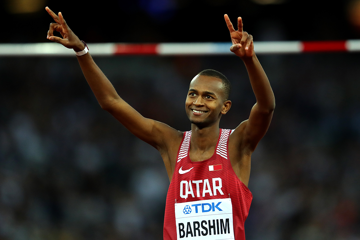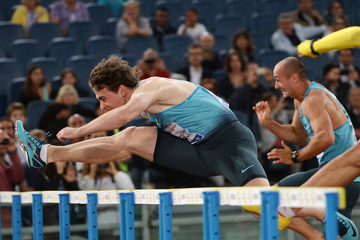Mutaz Essa Barshim in the high jump at the IAAF World Championships London 2017 (© Getty Images)
One year ago, Mutaz Barshim was flying high. Very high.
The 2017 World Athlete of the Year set the tone - and the bar - for the season early on, topping 2.40m to win at the Doha Diamond League for the second straight year. That’s a height only a dozen others had ever topped, and Barshim, then 26, had sailed clear in his first major outdoor meet of the year. A pair of 2.36m efforts in Eugene and Oslo followed, then a 2.38m clearance in mid-June for victory in Ostrava.
He topped 2.40m again two weeks later at the Gyulai Memorial in Székesfehérvár, Hungary, on 2 July and, feeling good, had the bar raised to a would-be world record of 2.46m. He came tantalisingly close with his first attempt, grazing the bar slightly on his way up before it fell, almost with hesitation, softly to the ground. He would later characterise it as one of his best jumps ever.
The Qatari star followed up with a decent attempt on his second try but landed clutching his left ankle after his third. So instead of a post-victory high, his latest assault on Javier Sotomayor’s 2.45m world record, which has stood for a quarter of a century, left his body broken, sidelining him for the rest of the season.
“I thought it was worse because I never experienced so harsh a pain as that moment,” he recalls. “So I thought I broke my bone. I thought, 'my foot is definitely broken'. We then found it wasn't broken but the ligaments were torn. It’s a little bit strange - at one moment I'm trying the world record and a few moments later I can't even walk.”
He underwent surgery to repair the ruptured ligaments eight days later, and was initially expected to be out of action for three to four months. Instead, he only resumed light training just over a month ago.
“It's been a rough six months,” Barshim, who sits second on the world all-time list at 2.43m, said earlier this month in Doha. “Not because of the injuries but because I wasn't able to jump. I always want to be at the stadium. So me not being able to be at a stadium is like some part of me is missing. So I’m really happy I'm back now.”
He began with some jogging and light running in late April and recently began jumping again in training. But the date of his season’s debut has not yet been confirmed. “Now it's really a matter of me getting back in shape and then build myself back up to the point where I can compete.”
After near-miss, ‘I lost respect for the record’
Barshim said there was plenty of frustration to work through in the ensuing months, but eventually was able to take it in stride.
“In sport these things happen. At the time I chose to become a professional athlete I was very well aware of this. And I dedicated myself to that.”
Barshim has sat second on the world all-time list since September 2014 when he scaled 2.43m at the Diamond League final in Brussels. He’s been chasing Sotomayor since and has never come as close as he did the last time he dressed in his competition gear. Did pushing his body to a near-absolute limit and having it break along the way leave him with a renewed respect for the world record?
Not really.
“I'll tell you two things,” he said. “Definitely, if you want to push yourself to a world record, you have to understand that there is only one human being in this whole universe who has done that. And there is definitely a reason. Me approaching a world record, I'm definitely trying 120 percent. You can’t go for a world record thinking, 'Oh, I'm going to be careful, I'm only going 80 percent. That doesn't work. It's a world record for a reason so you have to give everything you have. Despite what might happen later.
“But in terms of having more respect for it, I think it's the opposite for me. That attempt gave me so much confidence, that actually I lost respect for the record. I thought, 'You know what? I almost had it'. So it's actually given me that extra push. Next time I'll have it. Now I know how to deal with it.”
Was that near-miss his best-ever jump?
“One of them, definitely not the best. In high jump you have to be prepared physically and mentally. Physically, of course it's really hard work. But it's easier than to be mentally prepared for it. I feel in the past four years I was ready physically, but not mentally for that barrier. But in my last jump, when I got injured, I think it was the opposite. Mentally I was way above that but physically I wasn't there yet because it was the beginning of the season - it was just June. So hopefully now I can combine both. I'm just hoping for my physical to return because my mental is way up.”
In the meantime, recovery is key as he sets out on a course to defend his world title at the IAAF World Athletics Championships Doha 2019 later this year where he’ll share centre stage alongside 400m hurdles ace Abderrahman Samba as one of the Championships’ poster boys. He said that he and long-time coach Stanisław Szczyrba aren’t planning to make any adjustments to the training regimen that has brought them this far.
“My training in the past five or six years has been the same. My program has been working so why would I change anything? I intend to keep doing the same thing, but of course I'm going to listen to myself much more. If I definitely feel a pain or something, I'm going to slow down or stop. Otherwise, 110 percent. I'm going for it.”
Bob Ramsak for the IAAF






